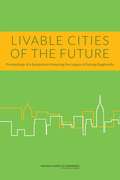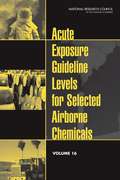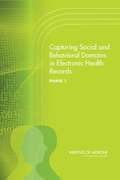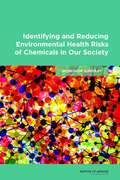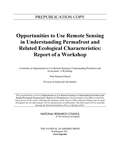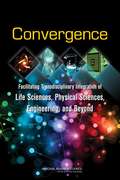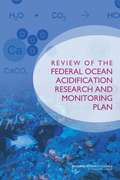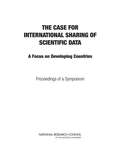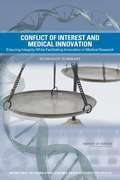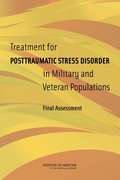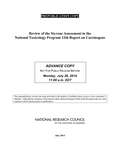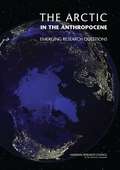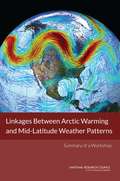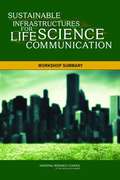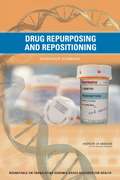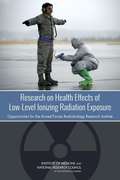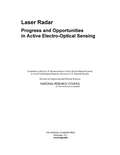- Table View
- List View
2013-2014 Assessment of the Army Research Laboratory: Interim Report
by Army Research Laboratory Technical Assessment BoardThe National Research Council's Army Research Laboratory Technical Assessment Board provides biennial assessments of the scientific and technical quality of the research, development, and analysis programs at the Army Research Laboratory, focusing on ballistics sciences, human sciences, information sciences, materials sciences, and mechanical sciences. This interim report summarizes the findings of the Board for the first year of this biennial assessment. During the first year the Board examined the following elements: within ballistic sciences, terminal ballistics; within human sciences, translational neuroscience and soldier simulation and training technology; within information sciences, autonomous systems; and within materials sciences, energy materials and devices, photonic materials and devices, and biomaterials. The review of autonomous systems included examination of the mechanical sciences competency area for autonomous systems. A second, final report will subsume the findings of this interim report and add the findings from the second year of the review, during which the Board will examine additional elements.
Livable Cities of the Future: Proceedings of a Symposium Honoring the Legacy of George Bugliarello
by Mohammad KaramouzAt the beginning of the 20th century an estimated five percent of the world's population lived in cities. Today, half the world's population is urbanized. Urban sustainability is multifaceted and encompasses security, economics, environment and resources, health, and quality of life. It can be viewed as the intersection of two extremely complex and not yet fully understood processes, urbanization and global sustainability, which will increasingly overlap as urban populations continue to grow. Effective policies are critical for addressing urban sustainability, and must be politically realistic in deciding on appropriate balances, such as centralized versus decentralized systems, "soft" versus "hard" solutions, local versus regional focus, agriculture versus pollution, and free markets versus interventions. Livable Cities of the Future, a symposium honoring the legacy of George Bugliarello, was hosted October 26, 2012, by the Polytechnic Institute of New York University (NYU-Poly) in the Pfizer Auditorium of the Bern Dibner Library of Science and Technology. The event brought together more than 200 engineers, civic leaders, educators, and futurists to discuss how George Bugliarello's vision manifests itself in innovative urban planning for the cities of tomorrow. This report is a summary of the presentations and discussion at that event. The symposium objectives were to cultivate ideas for best practices and innovative strategies for sustainable urban development and to facilitate the evolution of New York City to a real-life laboratory for urban innovation. Participants heard the perspectives and experiences of representatives from private and public service operators, infrastructure agencies, and the academic community. Elected officials and other stakeholders in urban and other sectors examined issues critical to resilient and sustainable cities, such as energy, water supply and treatment, public health, security infrastructure, transportation, telecommunications, and environmental protection.
Reaching Students: What Research Says About Effective Instruction in Undergraduate Science and Engineering
by Nancy KoberThe undergraduate years are a turning point in producing scientifically literate citizens and future scientists and engineers. Evidence from research about how students learn science and engineering shows that teaching strategies that motivate and engage students will improve their learning. So how do students best learn science and engineering? Are there ways of thinking that hinder or help their learning process? Which teaching strategies are most effective in developing their knowledge and skills? And how can practitioners apply these strategies to their own courses or suggest new approaches within their departments or institutions? Reaching Students strives to answer these questions. Reaching Students presents the best thinking to date on teaching and learning undergraduate science and engineering. Focusing on the disciplines of astronomy, biology, chemistry, engineering, geosciences, and physics, this book is an introduction to strategies to try in your classroom or institution. Concrete examples and case studies illustrate how experienced instructors and leaders have applied evidence-based approaches to address student needs, encouraged the use of effective techniques within a department or an institution, and addressed the challenges that arose along the way. The research-based strategies in Reaching Students can be adopted or adapted by instructors and leaders in all types of public or private higher education institutions. They are designed to work in introductory and upper-level courses, small and large classes, lectures and labs, and courses for majors and non-majors. And these approaches are feasible for practitioners of all experience levels who are open to incorporating ideas from research and reflecting on their teaching practices. This book is an essential resource for enriching instruction and better educating students.
Limited Affordable Low-Volume Manufacturing: Summary of a Workshop
by Maureen Mellody"Limited Affordable Low-Volume Manufacturing" is the summary of a workshop convened by the National Materials and Manufacturing Board of the National Research Council in August 2013 to discuss affordable, low-volume manufacturing. The workshop focused on four critical issues relevant to manufacturing: low-volume manufacturing; use of commercial off-the-shelf equipment; short production runs; and commercial manufacturing services. The workshop discussion also considered variable-rate manufacturing and high-mix manufacturing, both aspects of low-volume manufacturing. This report examines the characteristics of low-volume manufacturing and considers future advances in limited affordable low-volume manufacturing in the United States.
Safe Science: Promoting a Culture of Safety in Academic Chemical Research
by Committee on Establishing Promoting a Culture of Safety in Academic Laboratory ResearchRecent serious and sometimes fatal accidents in chemical research laboratories at United States universities have driven government agencies, professional societies, industries, and universities themselves to examine the culture of safety in research laboratories. These incidents have triggered a broader discussion of how serious incidents can be prevented in the future and how best to train researchers and emergency personnel to respond appropriately when incidents do occur. As the priority placed on safety increases, many institutions have expressed a desire to go beyond simple compliance with regulations to work toward fostering a strong, positive safety culture: affirming a constant commitment to safety throughout their institutions, while integrating safety as an essential element in the daily work of laboratory researchers. "Safe Science" takes on this challenge. This report examines the culture of safety in research institutions and makes recommendations for university leadership, laboratory researchers, and environmental health and safety professionals to support safety as a core value of their institutions. The report discusses ways to fulfill that commitment through prioritizing funding for safety equipment and training, as well as making safety an ongoing operational priority. A strong, positive safety culture arises not because of a set of rules but because of a constant commitment to safety throughout an organization. Such a culture supports the free exchange of safety information, emphasizes learning and improvement, and assigns greater importance to solving problems than to placing blame. High importance is assigned to safety at all times, not just when it is convenient or does not threaten personal or institutional productivity goals. "Safe Science" will be a guide to make the changes needed at all levels to protect students, researchers, and staff.
Acute Exposure Guideline Levels for Selected Airborne Chemicals
by National Research Council Committee on Toxicology Division On Earth Life Studies Board on Environmental Studies Toxicology Committee on Acute Exposure Guideline LevelsAcute Exposure Guideline Levels for Selected Airborne Chemicals, Volume 15 identifies, reviews, and interprets relevant toxicologic and other scientific data for ethyl mercaptan, methyl mercaptan, phenyl mercaptan, tert-octyl mercaptan, lewisite, methyl isothiocyanate, and selected monoisocyanates in order to develop acute exposure guideline levels (AEGLs) for these high-priority, acutely toxic chemicals. AEGLs represent threshold exposure limits (exposure levels below which adverse health effects are not likely to occur) for the general public and are applicable to emergency exposures ranging from 10 minutes (min) to 8 h. Three level--AEGL-1, AEGL-2, and AEGL-3--are developed for each of five exposure periods (10 min, 30 min, 1 h, 4 h, and 8 h) and are distinguished by varying degrees of severity of toxic effects. This report will inform planning, response, and prevention in the community, the workplace, transportation, the military, and the remediation of Superfund sites.
Considerations in Applying Benefit-Cost Analysis to Preventive Interventions for Children, Youth, and Families
by Steve OlsonBenefit-cost analyses hold great promise for influencing policies related to children, youth, and families. By comparing the costs of preventive interventions with the long-term benefits of those interventions, benefit-cost analysis provides a tool for determining what kinds of investments have the greatest potential to reduce the physical, mental, and behavioral health problems of young people. More generally, the growth of benefit-cost analysis as a field of research and practice represents an exciting and promising trend in the development and implementation of public policies. The utility of benefit-cost analyses has been limited by a lack of uniformity in the methods and assumptions underlying these studies. For years, those who perform and those who use benefit-cost analyses have argued that the development and use of theoretical, technical, and reporting standards for benefit-cost analyses would enhance the validity of results, increase comparability across studies, and accelerate the progress of the field. Considerations in Applying Benefit-Cost Analysis to Preventive Interventions for Children, Youth, and Families is the summary of a workshop convened by the Board on Children, Youth, and Families of the Institute of Medicine and the National Research Council in November 2013 as the first phase of a possible two-part effort directed toward guiding future benefit-cost studies and enhancing the relevance of benefit-cost analysis to governments and other organizations wanting to make sound prevention decisions. The workshop brought together leading practitioners in the field, researchers who study the methodological and analytic dimensions of benefit-cost analysis, and representatives of organizations that use the results of benefit-cost analyses to shape and implement public policies. This report discusses a wide range of issues about benefit-cost analysis, including the level of research rigor that should be met before results from an evaluation are used to estimate or predict outcomes in a cost-benefit analysis; best practices and methodologies for costing prevention interventions; prevention outcomes that currently lend themselves to monetization; processes and methodologies that should be used when linking prevention outcomes to avoided costs or increased revenues; and best methods for handling risk and uncertainty in estimates.
Capturing Social and Behavioral Domains in Electronic Health Records: Phase 1
by Committee on the Recommended Social Behavioral Domains Measures for Electronic Health RecordsSubstantial empirical evidence of the contribution of social and behavioral factors to functional status and the onset and progression of disease has accumulated over the past few decades. Electronic health records (EHRs) provide crucial information to providers treating individual patients, to health systems, including public health officials, about the health of populations, and to researchers about the determinants of health and the effectiveness of treatment. Inclusion of social and behavioral health domains in EHRs is vital to all three uses. The Health Information Technology for Economic and Clinical Health Act and the Patient Protection and Affordable Care Act place new importance on the widespread adoption and meaningful use of EHRs. "Meaningful use" in a health information technology context refers to the use of EHRs and related technology within a health care organization to achieve specified objectives. Achieving meaningful use also helps determine whether an organization can receive payments from the Medicare EHR Incentive Program or the Medicaid EHR Incentive Program. "Capturing Social and Behavioral Domains in Electronic Health Records" is the first phase of a two-phase study to identify domains and measures that capture the social determinants of health to inform the development of recommendations for meaningful use of EHRs. This report identifies specific domains to be considered by the Office of the National Coordinator, specifies criteria that should be used in deciding which domains should be included, identifies core social and behavioral domains to be included in all EHRs, and identifies any domains that should be included for specific populations or settings defined by age, socioeconomic status, race/ethnicity, disease, or other characteristics.
Identifying and Reducing Environmental Health Risks of Chemicals in Our Society: Workshop Summary
by Robert PoolOn November 7-8, 2013, the Institute of Medicine's Roundtable on Environmental Health Sciences, Research, and Medicine held a workshop to discuss approaches related to identifying and reducing potential environmental public health risks to new and existing industrial chemicals present in society. Industrial chemicals include chemicals used in industrial processes or commercial products, not including those found in food, pesticides, or pharmaceuticals. Identifying and Reducing Environmental Health Risks of Chemicals in Our Society is a summary and synthesis of the presentations and discussions that took place during the two days of the workshop. The workshop examined successes and areas for improvement within current regulatory programs for assessing industrial chemical safety, frameworks for chemical prioritization to inform targeted testing and risk management strategies, concepts of sustainability and green chemistry that support the design and use of safer alternatives, and efforts to reduce the risk of chemicals in our society.
Opportunities to Use Remote Sensing in Understanding Permafrost and Related Ecological Characteristics: Report of a Workshop
by Committee on Opportunities to Use Remote Sensing in Understanding Permafrost Ecosystems: A WorkshopPermafrost is a thermal condition -- its formation, persistence and disappearance are highly dependent on climate. General circulation models predict that, for a doubling of atmospheric concentrations of carbon dioxide, mean annual air temperatures may rise up to several degrees over much of the Arctic. In the discontinuous permafrost region, where ground temperatures are within 1-2 degrees of thawing, permafrost will likely ultimately disappear as a result of ground thermal changes associated with global climate warming. Where ground ice contents are high, permafrost degradation will have associated physical impacts. Permafrost thaw stands to have wide-ranging impacts, such as the draining and drying of the tundra, erosion of riverbanks and coastline, and destabilization of infrastructure (roads, airports, buildings, etc. ), and including potential implications for ecosystems and the carbon cycle in the high latitudes. "Opportunities to Use Remote Sensing in Understanding Permafrost and Related Ecological Characteristics" is the summary of a workshop convened by the National Research Council to explore opportunities for using remote sensing to advance our understanding of permafrost status and trends and the impacts of permafrost change, especially on ecosystems and the carbon cycle in the high latitudes. The workshop brought together experts from the remote sensing community with permafrost and ecosystem scientists. The workshop discussions articulated gaps in current understanding and potential opportunities to harness remote sensing techniques to better understand permafrost, permafrost change, and implications for ecosystems in permafrost areas. This report addresses questions such as how remote sensing might be used in innovative ways, how it might enhance our ability to document long-term trends, and whether it is possible to integrate remote sensing products with the ground-based observations and assimilate them into advanced Arctic system models. Additionally, the report considers the expectations of the quality and spatial and temporal resolution possible through such approaches, and the prototype sensors that are available that could be used for detailed ground calibration of permafrost/high latitude carbon cycle studies.
Evaluation of the Implementation of WFIRST/AFTA in the Context of New Worlds, New Horizons in Astronomy and Astrophysics
by Committee on an Assessment of the Astrophysics Focused Telescope Assets (AFTA) Mission Concepts"Evaluation of the Implementation of WFIRST in the Context of New Worlds, New Horizons in Astronomy and Astrophysics" assesses whether the proposed Astrophysics Focused Telescope Assets (AFTA) design reference mission described in the April 30, 2013 report of the AFTA Science Definition Team (SDT), WFIRST-2. 4, is responsive to the overall strategy to pursue the science objectives of "New Worlds, New Horizons in Astronomy and Astrophysics," and in particular, the survey's top ranked, large-scale, space-based priority: the Wide Field Infrared Survey Telescope (WFIRST). This report considers the versions of WFIRST-2. 4 with and without the coronagraph, as described in the AFTA SDT report. The report compares the WFIRST mission described in "New Worlds, New Horizons" to the AFTA SDT WFIRST-2. 4 design reference mission, with and without the coronagraph, on the basis of their science objectives, technical complexity, and programmatic rationale, including projected cost. This report gives an overview of relevant scientific, technical, and programmatic changes that have occurred since the release of "New Worlds, New Horizons," and assesses the responsiveness of the WFIRST mission to the science and technology objectives of the "New Worlds" report.
Convergence: Facilitating Transdisciplinary Integration of Life Sciences, Physical Sciences, Engineering, and Beyond
by Committee on Key Challenge Areas for Convergence HealthConvergence of the life sciences with fields including physical, chemical, mathematical, computational, engineering, and social sciences is a key strategy to tackle complex challenges and achieve new and innovative solutions. However, institutions face a lack of guidance on how to establish effective programs, what challenges they are likely to encounter, and what strategies other organizations have used to address the issues that arise. This advice is needed to harness the excitement generated by the concept of convergence and channel it into the policies, structures, and networks that will enable it to realize its goals. "Convergence" investigates examples of organizations that have established mechanisms to support convergent research. This report discusses details of current programs, how organizations have chosen to measure success, and what has worked and not worked in varied settings. The report summarizes the lessons learned and provides organizations with strategies to tackle practical needs and implementation challenges in areas such as infrastructure, student education and training, faculty advancement, and inter-institutional partnerships.
Review of the Federal Ocean Acidification Research and Monitoring Plan
by National Research Council Ocean Studies Board Committee on the Review of the National Ocean Acidification Research and Monitoring Plan Division on Earth and Life StudiesThe world's ocean has already experienced a 30% rise in acidity since the industrial revolution, with acidity expected to rise 100 to 150% over preindustrial levels by the end of this century. Potential consequences to marine life and also to economic activities that depend on a healthy marine ecosystem are difficult to assess and predict, but potentially devastating. To address this knowledge gap, Congress passed the Federal Ocean Acidification Research and Monitoring (FOARAM) Act in 2009, which, among other things, required that an interagency working group create a "Strategic Plan for Federal Research and Monitoring of Ocean Acidification." Review of the Federal Ocean Acidification Research and Monitoring Plan reviews the strategic plan on the basis of how well it fulfills program elements laid out in the FOARAM Act and follows the advice provided to the working group in the NRC's 2010 report, Ocean Acidification: A National Strategy to Meet the Challenges of a Changing Ocean. This report concludes that, overall, the plan is strong and provides a comprehensive framework for improving our understanding of ocean acidification. Potential improvements include a better defined strategy for implementing program goals, stronger integration of the seven broad scientific themes laid out in the FOARAM Act, and better mechanisms for coordination among federal agencies and with other U.S. and international efforts to address ocean acidification.
The Case for International Sharing of Scientific Data: Proceedings of a Symposium
by Kathie Bailey MathaeThe theme of this international symposium is the promotion of greater sharing of scientific data for the benefit of research and broader development, particularly in the developing world. This is an extraordinarily important topic. Indeed, I have devoted much of my own career to matters related to the concept of openness. I had the opportunity to promote and help build the open courseware program at the Massachusetts Institute of Technology (MIT). This program has made the teaching materials for all 2,000 subjects taught at MIT available on the Web for anyone, anywhere, to use anytime at no cost. In countries where basic broadband was not available, we shipped it in on hard drives and compact disks. Its impact has been worldwide, but it has surely had the greatest impact on the developing world. I am also a trustee of a nonprofit organization named Ithaca that operates Journal Storage (JSTOR) and other entities that make scholarly information available at very low cost. The culture of science has been international and open for centuries. Indeed, the scientific enterprise can only work when all information is open and accessible, because science works through critical analysis and replication of results. In recent years, as some scientific data, and especially technological data, have increased in economic value frequently has caused us to be far less open with information than business and free enterprise require us to be. Indeed, the worldwide shift to what is known as open innovation is strengthening every day. Finally, since the end of World War II, the realities of modern military conflict and now terrorism have led governments to restrict information through classification. This is important, but I believe that we classify far too much information. The last thing we need today, at the beginning of the twenty-first century, is further arbitrary limitations on the free flow of scientific information, whether by policies established by governments and businesses, or by lack of information infrastructure. For all these reasons, the international sharing of scientific data is one of the topics of great interest here at the National Academies and has been the subject of many of our past reports. This is the primary reason why this symposium has been co-organized by the NRC's Policy and Global Affairs Division-the Board on International Scientific Organizations (BISO) and the Board on Research Data and Information (BRDI). The Case for International Sharing of Scientific Data: A Focus on Developing Countries: Proceedings of a Symposium summarizes the symposium.
Conflict of Interest and Medical Innovation: Workshop Summary
by Sarah H. BeachyScientific advances such as the sequencing of the human genome have created great promise for improving human health by providing a greater understanding of disease biology and enabling the development of new drugs, diagnostics, and preventive services. However, the translation of research advances into clinical applications has so far been slower than anticipated. This is due in part to the complexity of the underlying biology as well as the cost and time it takes to develop a product. Pharmaceutical companies are adapting their business models to this new reality for product development by placing increasing emphasis on leveraging alliances, joint development efforts, early-phase research partnerships, and public-private partnerships. These collaborative efforts make it possible to identify new drug targets, enhance the understanding of the underlying basis of disease, discover novel indications for the use of already approved products, and develop biomarkers for disease outcomes or directed drug use. While the potential benefits of collaboration are significant, the fact that the relationships among development partners are often financial means that it is vital to ensure trust by identifying, disclosing, and managing any potential sources of conflict that could create bias in the research being performed together. "Conflict of Interest and Medical Innovation" is the summary of a workshop convened by the Institute of Medicine Roundtable on Translating Genomic-Based Research for Health in June 2013 to explore the appropriate balance between identifying and managing conflicts of interest and advancing medical innovation. A wide range of stakeholders, including government officials, pharmaceutical company representatives, academic administrators and researchers, health care providers, medical ethicists, patient advocates, and consumers, were invited to present their perspectives and participate in discussions during the workshop. This report focuses on current conflict of interest policies and their effect on medical innovation in an effort to identify best practices and potential solutions for facilitating innovation while still ensuring scientific integrity and public trust.
Treatment for Posttraumatic Stress Disorder in Military and Veteran Populations: Final Assessment
by Committee on the Assessment of Ongoing Efforts in the Treatment of Posttraumatic Stress DisorderPosttraumatic stress disorder (PTSD) is one of the signature injuries of the U. S. conflicts in Afghanistan and Iraq, but it affects veterans of all eras. It is estimated that 7-20% of service members and veterans who served in Operation Enduring Freedom and Operation Iraqi Freedom may have the disorder. PTSD is characterized by a combination of mental health symptoms - re-experiencing of a traumatic event, avoidance of trauma-associated stimuli, adverse alterations in thoughts and mood, and hyperarousal - that last at least 1 month and impair functioning. PTSD can be lifelong and pervade all aspects of a service member's or veteran's life, including mental and physical health, family and social relationships, and employment. It is often concurrent with other health problems, such as depression, traumatic brain injury, chronic pain, substance abuse disorder, and intimate partner violence. The Department of Defense (DoD) and the Department of Veterans Affairs (VA) provide a spectrum of programs and services to screen for, diagnose, treat for, and rehabilitate service members and veterans who have or are at risk for PTSD. The 2010 National Defense Authorization Act asked the Institute of Medicine to assess those PTSD programs and services in two phases. The Phase 1 study, "Treatment for Posttraumatic Stress Disorder in Military and Veteran Populations: Initial Assessment," focused on data gathering. "Treatment for Posttraumatic Stress Disorder in Military and Veteran Populations Final Assessment" is the report of the second phase of the study. This report analyzes the data received in Phase 1 specifically to determine the rates of success for each program or method. "Treatment for Posttraumatic Stress Disorder in Military and Veteran Populations Final Assessment" considers what a successful PTSD management system is and whether and how such a system is being implemented by DoD and VA. This includes an assessment of what care is given and to whom, how effectiveness is measured, what types of mental health care providers are available, what influences whether a service member or veteran seeks care, and what are the costs associated with that care. This report focuses on the opportunities and challenges that DoD and VA face in developing, implementing, and evaluating services and programs in the context of achieving a high-performing system to care for service members and veterans who have PTSD. The report also identifies where gaps or new emphases might be addressed to improve prevention of, screening for, diagnosis of, and treatment and rehabilitation for the disorder. The findings and recommendations of "Treatment for Posttraumatic Stress Disorder in Military and Veteran Populations: Final Assessment" will encourage DoD and VA to increase their efforts in moving toward a high-performing, comprehensive, integrated PTSD management strategy that addresses the needs of current and future service members, veterans, and their families.
Review of the Styrene Assessment in the National Toxicology Program 12th Report on Carcinogens
by Committee to Review the Styrene Assessment in the National Toxicology Program 12th Report on CarcinogensMany people in the United States are exposed to styrene. Sources of environmental exposure included food (from migration of styrene from polymer packaging materials), cigarette smoke, vehicle exhaust and other forms of combustion and incineration of styrene polymers. Occupational exposure to humans can occur during the industrial processing of styrene. It is used to create a broad spectrum of products, including latex paints and coatings; synthetic rubbers; construction materials, such as pipes, fittings, and lighting fixtures; packaging; household goods, such as synthetic marble, flooring, and molded furnishings; and automotive parts. In 2011, the National Toxicology Program (NTP) listed styrene as "reasonably anticipated to be a human carcinogen" in its 12th Report on Carcinogens, marking the first time that the substance was listed. Congress directed the Department of Health and Human Services to arrange for the National Academy of Sciences to independently review the substance profile of styrene and it listing in the NTP report. "Review of the Styrene Assessment in the National Toxicology Program 12th Report on Carcinogens" concurs with the NTP determination that there is limited but credible evidence that exposure to styrene in some occupational settings is associated with an increase in the frequency of lymphohematopoietic cancers. Additionally, the NRC report authoring committee independently reviewed the scientific evidence from studies in humans, experimental animals, and other studies relevant to the mechanisms of carcinogenesis and made level-of-evidence conclusions. Based on credible but limited evidence of carcinogenicity in traditional epidemiologic studies, on sufficient evidence of carcinogenicity in animals, and on convincing evidence that styrene is genotoxic in exposed humans, this report finds that compelling evidence exists to support a listing of styrene as, at a minimum, "reasonably anticipated to be a human carcinogen. "
The Arctic in the Anthropocene: Emerging Research Questions
by Committee on Emerging Research Questions in the ArcticOnce ice-bound, difficult to access, and largely ignored by the rest of the world, the Arctic is now front and center in the midst of many important questions facing the world today. Our daily weather, what we eat, and coastal flooding are all interconnected with the future of the Arctic. The year 2012 was an astounding year for Arctic change. The summer sea ice volume smashed previous records, losing approximately 75 percent of its value since 1980 and half of its areal coverage. Multiple records were also broken when 97 percent of Greenland's surface experienced melt conditions in 2012, the largest melt extent in the satellite era. Receding ice caps in Arctic Canada are now exposing land surfaces that have been continuously ice covered for more than 40,000 years. What happens in the Arctic has far-reaching implications around the world. Loss of snow and ice exacerbates climate change and is the largest contributor to expected global sea level rise during the next century. Ten percent of the world's fish catches comes from Arctic and sub-Arctic waters. The U. S. Geological Survey estimated that up to 13 percent of the world's remaining oil reserves are in the Arctic. The geologic history of the Arctic may hold vital clues about massive volcanic eruptions and the consequent release of massive amount of coal fly ash that is thought to have caused mass extinctions in the distant past. How will these changes affect the rest of Earth? What research should we invest in to best understand this previously hidden land, manage impacts of change on Arctic communities, and cooperate with researchers from other nations? "The Arctic in the Anthropocene" reviews research questions previously identified by Arctic researchers, and then highlights the new questions that have emerged in the wake of and expectation of further rapid Arctic change, as well as new capabilities to address them. This report is meant to guide future directions in U. S. Arctic research so that research is targeted on critical scientific and societal questions and conducted as effectively as possible. "The Arctic in the Anthropocene" identifies both a disciplinary and a cross-cutting research strategy for the next 10 to 20 years, and evaluates infrastructure needs and collaboration opportunities. The climate, biology, and society in the Arctic are changing in rapid, complex, and interactive ways. Understanding the Arctic system has never been more critical; thus, Arctic research has never been more important. This report will be a resource for institutions, funders, policy makers, and students. Written in an engaging style, "The Arctic in the Anthropocene" paints a picture of one of the last unknown places on this planet, and communicates the excitement and importance of the discoveries and challenges that lie ahead.
Linkages Between Arctic Warming and Mid-Latitude Weather Patterns: Summary of a Workshop
by Katie ThomasThe Arctic has been undergoing significant changes in recent years. Average temperatures are rising twice as fast as they are elsewhere in the world. The extent and thickness of sea ice is rapidly declining. Such changes may have an impact on atmospheric conditions outside the region. Several hypotheses for how Arctic warming may be influencing mid-latitude weather patterns have been proposed recently. For example, Arctic warming could lead to a weakened jet stream resulting in more persistent weather patterns in the mid-latitudes. Or Arctic sea ice loss could lead to an increase of snow on high-latitude land, which in turn impacts the jet stream resulting in cold Eurasian and North American winters. These and other potential connections between a warming Arctic and mid-latitude weather are the subject of active research. "Linkages Between Arctic Warming and Mid-Latitude Weather Patterns" is the summary of a workshop convened in September 2013 by the National Research Council to review our current understanding and to discuss research needed to better understand proposed linkages. A diverse array of experts examined linkages between a warming Arctic and mid-latitude weather patterns. The workshop included presentations from leading researchers representing a range of views on this topic. The workshop was organized to allow participants to take a global perspective and consider the influence of the Arctic in the context of forcing from other components of the climate system, such as changes in the tropics, ocean circulation, and mid-latitude sea surface temperature. This report discusses our current understanding of the mechanisms that link declines in Arctic sea ice cover, loss of high-latitude snow cover, changes in Arctic-region energy fluxes, atmospheric circulation patterns, and the occurrence of extreme weather events; possible implications of more severe loss of summer Arctic sea ice upon weather patterns at lower latitudes; major gaps in our understanding, and observational and/or modeling efforts that are needed to fill those gaps; and current opportunities and limitations for using Arctic sea ice predictions to assess the risk of temperature/precipitation anomalies and extreme weather events over northern continents.
Sustainable Infrastructures for Life Science Communication
by Elizabeth Stallman BrownAdvances in the life sciences - from the human genome to biotechnology to personalized medicine and sustainable communities - have profound implications for the well-being of society and the natural world. Improved public understanding of such scientific advances has the potential to benefit both individuals and society through enhanced quality of life and environmental protection, improved K-12 and undergraduate science education, greater understanding of human connections to the natural world, and more sustainable policies and regulations. Yet few systems of support exist to help life scientist communicators share their research with a broad range of public audiences, or engage the public in discussions about their work. "Sustainable Infrastructures for Life Science Communication" is the summary of a two-part workshop convened in December 2013 and January 2014 by the National Research Council Roundtable on Public Interfaces of the Life Sciences to identify infrastructure-related barriers that inhibit or prohibit life scientists from communicating about their work and characteristics of infrastructure that facilitate or encourage scientists to engage with public audiences. The workshop featured both formal presentations and panel discussions among participants from academia, industry, journalism, the federal government, and nonprofit organizations. The presentations highlighted the motivations of and challenges to life scientist communicators, theoretical approaches to science communication, examples of different types of infrastructure to support science communication, and the need for building more sustainable science communication infrastructures. This report considers communication infrastructure across a range of life science institutions, including federal agencies, academia, industry, and nonprofit organizations and explores novel approaches to facilitate effective science communication.
Drug Repurposing and Repositioning: Workshop Summary
by Sarah H. BeachyDrug development can be time-consuming and expensive. Recent estimates suggest that, on average, it takes 10 years and at least $1 billion to bring a drug to market. Given the time and expense of developing drugs de novo, pharmaceutical companies have become increasingly interested in finding new uses for existing drugs - a process referred to as drug repurposing or repositioning. Historically, drug repurposing has been largely an unintentional, serendipitous process that took place when a drug was found to have an offtarget effect or a previously unrecognized on-target effect that could be used for identifying a new indication. Perhaps the most recognizable example of such a successful repositioning effort is sildenafil. Originally developed as an anti-hypertensive, sildenafil, marketed as Viagra and under other trade names, has been repurposed for the treatment of erectile dysfunction and pulmonary arterial hypertension. Viagra generated more than $2 billion worldwide in 2012 and has recently been studied for the treatment of heart failure. Given the widespread interest in drug repurposing, the Roundtable on Translating Genomic-Based Research for Health of the Institute of Medicine hosted a workshop on June 24, 2013, in Washington, DC, to assess the current landscape of drug repurposing activities in industry, academia, and government. Stakeholders, including government officials, pharmaceutical company representatives, academic researchers, regulators, funders, and patients, were invited to present their perspectives and to participate in workshop discussions. Drug Repurposing and Repositioning is the summary of that workshop. This report examines enabling tools and technology for drug repurposing; evaluates the business models and economic incentives for pursuing a repurposing approach; and discusses how genomic and genetic research could be positioned to better enable a drug repurposing paradigm.
Research on Health Effects of Low-Level Ionizing Radiation Exposure: Opportunities for the Armed Forces Radiobiology Research Institute
by Committee on Research Directions in Human Biological Effects of Low-Level Ionizing RadiationIt is probably only a matter of time before we witness the next event in which large numbers of people are exposed to ionizing radiation. In the past, planning a response to such an occurrence would have likely focused on the management of casualties from high-dose exposure. However, more recently, a different threat has come to the fore: accidental (through a containment breach in a nuclear power plant, for example) or intentional (via a "dirty bomb") releases of radioactivity resulting in low-dose exposure to a population. The magnitude of the health risks arising from low-dose radiation exposure is uncertain, and this uncertainty has significant economic implications for public health decision making. "Research on Health Effects of Low-Level Ionizing Radiation Exposure" examines recent scientific knowledge about the human effects of exposure to low-dose radiation from medical, occupational, and environmental ionizing-radiation sources. This report is intended to provide advice to the Armed Forces Radiobiology Research Institute (AFRRI) about its role in low-dose radiation health effects research. The report identifies current research directions in radiobiological science and assesses how AFRRI programs are advancing research along these directions. The recommendations of "Research on Health Effects of Low-Level Ionizing Radiation Exposure" will provide guidance for AFRRI to build on its strengths and advance its mission while contributing to the body of scientific knowledge on the health effects of exposure to low-dose ionizing radiation.
Laser Radar
by Division on Engineering and Physical Sciences Committee on Review of Advancements in Active Electro-Optical Systems to Avoid Technological Surprise Adverse to U.S. National Security National Research CouncilIn today's world, the range of technologies with the potential to threaten the security of U.S. military forces is extremely broad. These include developments in explosive materials, sensors, control systems, robotics, satellite systems, and computing power, to name just a few. Such technologies have not only enhanced the capabilities of U.S. military forces, but also offer enhanced offensive capabilities to potential adversaries - either directly through the development of more sophisticated weapons, or more indirectly through opportunities for interrupting the function of defensive U.S. military systems. Passive and active electro-optical (EO) sensing technologies are prime examples. Laser Radar considers the potential of active EO technologies to create surprise; i.e., systems that use a source of visible or infrared light to interrogate a target in combination with sensitive detectors and processors to analyze the returned light. The addition of an interrogating light source to the system adds rich new phenomenologies that enable new capabilities to be explored. This report evaluates the fundamental, physical limits to active EO sensor technologies with potential military utility; identifies key technologies that may help overcome the impediments within a 5-10 year timeframe; considers the pros and cons of implementing each existing or emerging technology; and evaluates the potential uses of active EO sensing technologies, including 3D mapping and multi-discriminate laser radar technologies.
Harvesting the Fruits of Inquiry: How Materials Discoveries Improve Our Lives
by Ad Hoc Committee on Societal Benefits from Condensed Matter Materials ResearchThe field of condensed matter and materials research has played a key role in meeting our nation's needs in a number of areas, including energy, health, and climate change. Harvesting the Fruits of Inquiry highlights a few of the societal benefits that have flowed from research in this field. This report communicates the role that condensed matter and materials research plays in addressing societal needs. The report uses examples to illustrate how research in this area has contributed directly to efforts to address the nation's needs in providing sustainable energy, meeting health needs, and addressing climate change issues. Written in an accessible style, this report will be of interest to academia, government agencies, and Congress.
Hearing Loss and Healthy Aging: Workshop Summary
by Tracy A. LustigBeing able to communicate is a cornerstone of healthy aging. People need to make themselves understood and to understand others to remain cognitively and socially engaged with families, friends, and other individuals. When they are unable to communicate, people with hearing impairments can become socially isolated, and social isolation can be an important driver of morbidity and mortality in older adults. Despite the critical importance of communication, many older adults have hearing loss that interferes with their social interactions and enjoyment of life. People may turn up the volume on their televisions or stereos, miss words in a conversation, go to fewer public places where it is difficult to hear, or worry about missing an alarm or notification. In other cases, hearing loss is much more severe, and people may retreat into a hard-to-reach shell. Yet fewer than one in seven older Americans with hearing loss use hearing aids, despite rapidly advancing technologies and innovative approaches to hearing health care. In addition, there may not be an adequate number of professionals trained to address the growing need for hearing health care for older adults. Further, Medicare does not cover routine hearing exams, hearing aids, or exams for fitting hearing aids, which can be prohibitively expensive for many older adults. "Hearing Loss and Healthy Aging" is the summary of a workshop convened by the Forum on Aging, Disability, and Independence in January 2014 on age-related hearing loss. Researchers, advocates, policy makers, entrepreneurs, regulators, and others discussed this pressing social and public health issue. This report examines the ways in which age-related hearing loss affects healthy aging, and how the spectrum of public and private stakeholders can work together to address hearing loss in older adults as a public health issue.

